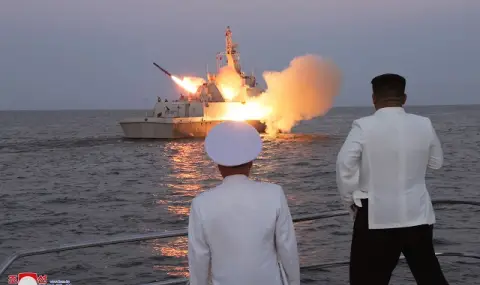North Korean ballistic missiles fired at Ukraine by Russian forces since late December have been much more precise than those fired last year, two senior Ukrainian sources told Reuters.
At a time when Moscow's growing ties with Pyongyang have raised concerns from Washington to Seoul, the increase in accuracy - to within 50-100 meters of the target - suggests that North Korea is successfully using the battlefield to test its missile technology, the sources said.
A military source, speaking on condition of anonymity to discuss sensitive information, described a significant improvement in accuracy in all of the more than 20 North Korean ballistic missiles that have hit Ukraine in recent weeks. A second source, a senior government official familiar with the matter, confirmed the findings when asked by the British agency.
Yang Wook, a weapons expert at the Asan Institute for Policy Studies in Seoul, said such improvements in North Korea's missile capabilities had worrying implications for its potential to threaten South Korea, Japan and the United States or to sell modernized weapons to "failed" states or armed groups.
"This could have a serious impact on regional and global stability," he said in response to questions for this story.
North Korea's military programs have been developing rapidly in recent years, including short- and medium-range missiles that Pyongyang says can be equipped with nuclear warheads. However, until its involvement in Ukraine, the long-isolated country had never tested the new weapons in combat conditions.
The US Pentagon and the Office of the Director of National Intelligence declined to comment.
FEEDBACK FROM CUSTOMERS
Military expert Yang said his security contacts in Ukraine had also independently reported improvements in recent batches of North Korean missiles.
“Because they manufacture missiles and receive feedback from customers - the Russian military - then they have more experience in creating more reliable missiles”, he said.
The sources and Yang said it was unclear what modifications North Korea had made.
A military source told the British agency that forensic analysis of the debris had not found any changes to the design of the missiles, although very little debris remained for analysis.
Two possible explanations are that the missiles were equipped with better navigation systems or a control mechanism to aid maneuvering, the source said.
According to Yang, other factors that could improve accuracy include better guidance information for crews, new guidance system components provided by Russia, and improvements based on data and experience that North Korean scientists have gathered during the war.
At the beginning of the war, the missiles had an accuracy of 1 to 3 kilometers, and the latest ones are accurate between 50 and 100 meters, the military source said in an interview in Kiev on January 27, revealing a previously undisclosed estimate for the first time.
The source declined to publicly disclose what the targets were, where the missiles were launched from or the dates of the attacks, citing military secrecy.
Russia began firing North Korean short-range ballistic missiles K-23, K-23A and K-24 at Ukraine in late 2023 and has since fired about 100 missiles, the source said. Kiev says Russia has also received millions of artillery shells and thousands of soldiers from Pyongyang to support its military efforts.
North Korea is expanding the complex where K-23 missiles are produced, the British news agency reported in November.
In February 2024 Ukraine's prosecutor general has cast doubt on the reliability of the little-known North Korean weapon, saying only two of the 24 missiles fired so far have been “relatively accurate“.
According to the source, the improvement in the weapons' accuracy came suddenly, after months of inaccurate launches. The new assessment is based on where the missiles - identified as North Korean by inspections of the blast sites - fell in relation to the alleged target nearby, the source said.
The British agency stressed that it could not independently verify the sources' assessment.
Although North Korea's ballistic missiles represent only a small fraction of Russia's missile strikes, they carry a large warhead weighing up to one ton and have a range of up to 800 km, the military source said. The equivalent Russian missile, the "Iskander-M", carries a smaller warhead and has a shorter range of 500 km.
Moscow and Pyongyang have been rapidly growing closer since 2023, when Russia's then-defense minister visited North Korea. The two powers signed a treaty on "Comprehensive Strategic Partnership" last year.
When then-US Secretary of State Anthony Blinken visited Seoul in November, he warned that Pyongyang’s deepening ties with Moscow were a threat to global non-proliferation regimes.
In November, South Korea’s national security adviser, Shin Won-sik, said that Russia had provided North Korea with anti-aircraft missiles and air defense equipment in exchange for troops and weapons supplies.
According to South Korea’s intelligence agency, Moscow may also be providing North Korea with missile parts and financial support, as well as space technology.
“North Korea is getting something,” Yang said.
Combat tests on Ukrainian terrain! North Korean ballistic missiles are becoming more accurate
Although North Korean ballistic missiles account for only a small fraction of Russia's missile strikes, they carry a large warhead weighing up to a ton and have a range of up to 800 km
Feb 6, 2025 12:59 165
